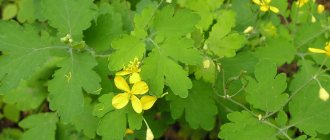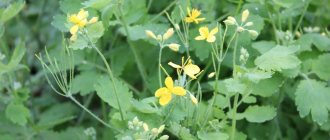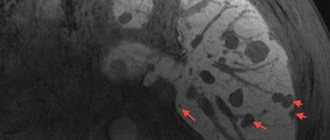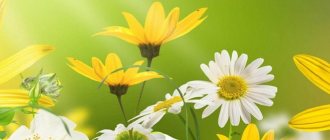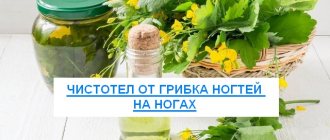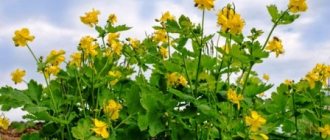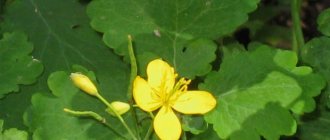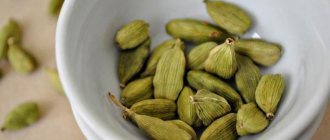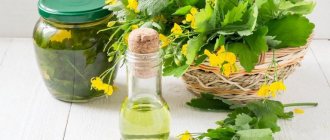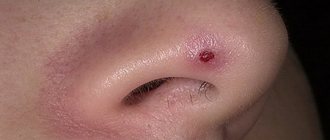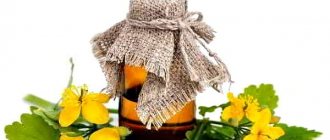This perennial plant is popularly called warthog, jaundice, cape grass, swallow grass or witch grass. All these names refer to the great celandine of the poppy family, whose official Latin name is Chelidónium május. A weed with bright yellow inflorescences, familiar from childhood, has long been used as a medicinal plant and helps to cope with a number of ailments.
Botanical description
Celandine reaches a height of 0.3-1.1 m, structural features vary depending on living conditions. The stem is hollow, ribbed, covered with sparse villi, and branches at the top. The leaves are light green, with a slight bluish tint on the inside, arranged alternately. In the lower part of the stem they are petiolate, in the upper part they are sessile. They have a feathery shape, consist of three to five pairs of round or oval lobes with a dissected surface. The root is branched, brownish-red on the outside, orange-yellowish when cut.
The flowers are yellow, consisting of four petals, collected in umbrellas of five to eight pieces. The plant does not have honey glands that secrete nectar, but attracts insects with an abundance of pollen. Flowering occurs from May to June, in some climatic zones it continues until September. The fruits - pods 0.5 cm long - ripen in August-October. Seeds with a diameter of 1-1.5 mm, black-brown, with a lacquered sheen and a whitish appendage in the form of a ridge.
A distinctive characteristic of celandine, from a botanical point of view, is the release of a caustic milky juice when leaves or stems with flowers are broken, which acquires a bright orange hue in the air. The plant is toxic and is not eaten by herbivores.
Description and distribution
What does celandine look like? This is a perennial herbaceous plant with a short hollow rhizome and tap root, height -100 cm of the poppy family.
The root is taproot, branched, with a short rhizome. Stems are ribbed, leafy, branched. The leaves are alternate, green above, bluish below, spherical-pinnately dissected in outline. The flowers are yellow, on rather long stalks, collected in simple umbels and located on the tops of stems and branches.
The fruit is a pod up to 5 mm long, the seeds are ovoid, 1-2 mm long, black-brown, glossy with a comb-like white appendage, which is eaten by ants. At the same time, they spread seeds, facilitating the spread of the plant. For this reason, celandine is often found in anthills.
Blooms from May to autumn. Fruits from June to September. When mowing, secondary flowering is observed in July - August.
Grows in shady places, between bushes, along ravines in forests; does not form large thickets.
As a rule, this plant is a weed, but it is found in sparse coniferous and mixed forests, in clearings, clearings, and burnt areas; in parks, gardens, near roads; usually grows in groups, preferring moist and rich soils. It forms sparse thickets under the canopy of sparse forests.
It grows wild in vegetable gardens, gardens, vacant lots and near housing in the European part of Russia, Siberia, the Far East and the Caucasus. It is also found partially in Central Asia.
Where does celandine grow in Russia?
The plant's distribution range is in all regions, with the exception of the Arctic regions. It is found everywhere in European and Mediterranean countries, in China and even on the American continent, where it was brought by colonialists in the 17th century. Prefers temperate climate zones. It received the strange popular name “podtynnik” for its habit of living under every fence (or, as they said in the villages, “tynom”).
The Greeks noticed that celandine blooms with the arrival of swallows, and flowering ends when the birds leave the country, hence the name - swallow grass. Children and adults know what celandine looks like - after all, it can be seen everywhere in summer cottages, in gardens, in the city, where it grows like ordinary weeds. The grass is unpretentious and takes root even on poor soils.
In what places is celandine common?
Plants prefer shady corners in deciduous and coniferous thickets and river valleys, populating the surroundings of housing, vacant lots, roadsides, clearings and areas of fires. Ants that use celandine seeds for food transport them over considerable distances, helping to increase growth. Why the herb got its main name becomes clear if we remember that back in Ancient Rome it was used to remove warts, remove calluses and treat eczema.
Chemical composition
Greater celandine has been studied in detail by pharmacognosy and is used in the production of a whole range of medicinal products. Plant-based products have a multifaceted effect due to the substances contained in the raw materials:
- alkaloids (chelidonine, protopine, sanguinarine, helyrythrine, berberine, homochelidonine, etc.);
- essential oils;
- saponins;
- carotene;
- flavonoids;
- organic natural acids (succinic, chelidonic, citric, malic);
- vitamins of groups A and C;
- minerals (potassium, calcium, magnesium, iron, copper, zinc, bromine);
- tanning elements and resins.
The seeds contain coumarins, lipase and fatty oils. The plant is poisonous; only sika deer eat it without harm. When preparing medicines, you must strictly adhere to the proportions and dosages specified in the recipes. It is not recommended to take infusions and decoctions orally without consulting your doctor.
Side effects and contraindications of celandine
Before starting treatment with celandine, you need to carefully read all the contraindications to the use of such a medicinal plant. also very important to strictly adhere to the recommended dosage and duration of treatment. An absolute contraindication to the use of celandine-based products is epilepsy, pregnancy and breastfeeding, children under three years of age, as well as individual intolerance.
Such drugs should be used with great caution and under medical supervision by persons prone to neurological diseases, with a history of bronchial asthma and angina pectoris. Unreasonably long-term use, as well as overdose, can have a very negative impact on the health of the mucous membrane and cause dysbacteriosis or poisoning, accompanied by nausea, vomiting, convulsions and fainting.
Preparation of preparations from celandine
The optimal time for collecting medicinal raw materials is the flowering period. The upper parts of the plant are cut off without touching the roughened root areas of the stem. You need to take precautions: do not touch your face, wash your hands with soap after work. It is recommended to use gloves and safety glasses. Celandine is collected only in dry, clear weather. Plants that have a lush green color without signs of wilting or fungal attack should be cut. To preserve the growth, be sure to leave some of the grass for the seeds to ripen, and in the next two years, mowing is done in a different place.
Depending on the region, raw materials can be collected from May to August, while flowering continues. In autumn, after the above-ground part of the plant dies, or in early spring, when the first shoots appear, roots are harvested. They are collected, washed under cold water, excess parts are cut off and used for the preparation of homeopathic medicines.
Drying
To prepare celandine as a basis for future medicinal remedies, immediately after cutting the grass is sent to special dryers or laid out in a thin layer on paper in well-ventilated areas, protected from direct sunlight. To avoid rotting, you need to turn the plants regularly. When the stems break when bent, the raw material is considered dried. When packaging, it is recommended to wear masks, as microscopic particles of the herb irritate the nasal mucous membranes.
Storage
Raw materials are divided into whole and crushed (fragments of flowers, leaves, stems that freely pass through 7 mm sieve holes). In order to properly prepare celandine and make an effective medicine, it is necessary to strictly adhere to collection technologies and storage conditions. It is optimal to pack the grass in linen bags and keep it hanging in a dry, dark place. The healing qualities last for three years.
Celandine juice
Celandine juice is a traditional remedy for reducing dark spots on the skin, acne, calluses and warts. The method is painless and does not cause burning. You can use fresh plant juice, or you can prepare it from the stems, leaves and flowers of celandine. The finished juice is stored for up to 3 years in a cool place.
How to care for blackberries
Before using celandine to remove warts, get examined by a doctor - check whether the growth is not a malignant formation. Also use gloves when preparing juice, otherwise you will get painful burns.
If you have a large number of warts on your skin, treat no more than 5-6 growths in one course. The course of treatment with celandine for warts lasts 3 weeks.
Ingredients:
- Celandine grass (fresh) - 1 kg.
How to prepare : Rinse the celandine herb thoroughly under running water and dry. Pass the raw materials through a meat grinder and squeeze the resulting mass through three layers of gauze. Pour the juice into bottles, close with metal caps and place in a cool place. After 2-3 days, open the caps on the bottles and release the gas that formed during fermentation. Then close the containers tightly. Release the gas several times until the fermentation process is complete.
How to use : Wash the area of skin with warts well and steam in a soda-salt bath. Lubricate healthy areas with rich cream. Apply celandine juice to the growth 4 times a day. Remove any crusts that form.
Result : Juice from celandine extract cauterizes skin lesions, has an antitumor, antiviral and bactericidal effect. After 3 weeks of regular use, the warts darken and fall off.
Pharmacological properties of greater celandine
The composition of the herb, saturated with alkaloids, macro- and microelements, provides a wide-spectrum therapeutic effect - anti-inflammatory, antiseptic, antiviral, antifungal, analgesic, antispasmodic and others.
According to studies, celandine has a cytostatic and cytotoxic effect in the early stages of cancer: it inhibits the growth of malignant tumors, triggers the process of necrosis inside cancer cells, and prevents the formation of metastases.
For a long time, products prepared from the plant have helped get rid of papillomas, warts, acne, reduce the manifestations of eczema and other skin pathologies, and relieve itching. The substances included in celandine stimulate intestinal peristalsis, increase the secretion of saliva, and tone the muscles of the uterus. However, it is important to be careful: if celandine acts as a medicine in small quantities, an overdose can cause serious damage to health and cause symptoms of poisoning when consumed orally and burns when used externally.
Application in Chinese medicine
For a long time, in Chinese herbal medicine, greater celandine has been used as a remedy for the treatment of gastritis, ulcers, enteritis, jaundice, abdominal pain, bronchitis and whooping cough.
Recommended daily doses in China range from 3 to 9 g of celandine or even more. These relatively high doses are given as a decoction and can be justified by the fact that not too much chelidonine is released in this form. However, when using large doses, some patients reported varying degrees of side effects, such as dry mouth, dizziness, digestive discomfort, diarrhea, nausea, and decreased white blood cell counts. Symptoms disappeared without complications 3-5 days after treatment.
Dosage
Read: Gentian Yellow
The recommended dosage is 2.5 g of herb per day, which is equivalent to 12-30 mg of alkaloid content. It is worth noting that at such doses no side effects should occur.
Use of celandine in traditional medicine
The alkaloids included in the herb are used in the production of a number of medications. Medicines based on celandine fight the herpes virus and are used to treat an acute inflammatory process that affects the spinal cord and brain - encephalomyelitis. The bacteriostatic effect of products with plant extract exceeds the properties of antibiotics against staphylococcus and mycobacterium tuberculosis.
Combined preparations using celandine alkaloids are effective against gram-positive and gram-negative species of bacteria and fungi and are prescribed for such pathologies as:
- herpetic and ulcerative stomatitis;
- wound skin lesions that do not heal for a long time;
- trichomonas colpitis;
- polio;
- alveolar pyorrhea;
- erosion.
Chelidonine and berberine in medications reduce blood pressure. The choleretic, anti-inflammatory effect of alkaloids is used in the treatment of cholecystitis, pancreatitis, hepatitis, gastric and duodenal ulcers. Root extract is included in medications prescribed for the formation of gallstones. Research by Russian doctors has confirmed the benefits of celandine for intestinal polyps.
Traditional methods of treatment
The plant has been used since ancient times to combat skin diseases. Children were bathed in a decoction of celandine for scrofula. Ulcers and eczema were treated with infusion, they tried to lighten freckles and age spots with it. Based on the herb, remedies were prepared for the treatment of skin tuberculosis, psoriasis, and lupus. The rhizomes were boiled and used for dysentery. Crushed leaves were applied to festering wounds to combat infection. Tincture from the plant was used for diseases of the biliary tract, liver, and gastrointestinal pathologies.
In Tibetan medicine, celandine flowers have long been used to reduce fever. The Greek healer Theophrastus prescribed infusions from the plant for jaundice, stomach pain, and constipation. In Rus', wounds, burns, and ulcers were treated with a solution of alcohol or water. The broth also served as a disinfectant in the household - it was poured over clay pots and jars, and cream and milk were stored in them longer without turning sour. Recipes for preparing herbal medicine have been developed, which are also used in modern herbal medicine. Extracts of celandine are actively used in the manufacture of homeopathic remedies. In folk medicine, the stems, leaves, flowers, rhizomes and juice of the plant are used.
Indications for use
The medicinal collection is widely used in official medicine for the manufacture of medicines.
Pharmacists have developed a restorative gel based on the plant, “Clandestine,” which helps get rid of warts, as well as the drugs “Enterosanal” and “Plantasan B” (an ointment for the treatment of warts). The latter is approved for use for the treatment of cutaneous tuberculosis
Celandine preparations are used as an antispasmodic and also as an antimicrobial agent
In folk medicine, celandine is used for diseases of the liver and gall bladder. These may be diseases such as jaundice, sand in the liver, gallstones
It is also used for digestive disorders, as a painkiller. To get rid of warts, the milky juice of the plant is widely used.
The plant is often used to treat various skin diseases, including eczema, gout and others.
Preparation of medicines
The presence of biological substances with a wide spectrum of action in celandine makes it an effective remedy for combating diseases of various origins. Based on it, healing decoctions and infusions are prepared that help cope with a host of ailments.
Ointment
For one part of celandine juice, take four parts of petroleum jelly or lanolin. It is also acceptable to use crushed dried leaves. Helps to reduce warts, remove calluses, reduce the manifestations of dermatitis and eczema, and relieve itching. The finished ointment is placed in the refrigerator, where it retains its beneficial properties for one and a half to two years.
Collections with celandine for healing baths
Water procedures are an effective way of relaxation, and in combination with the anti-inflammatory and tonic effect of herbal decoctions they will bring maximum benefits. Baths with the addition of a mixture of herbs and greater celandine are effective for healing, treating and preventing diseases. It is recommended to use mixtures with chamomile, oregano, string, St. John's wort and other herbs.
All plants are collected and dried separately, and then mixed in equal proportions. It is advisable to store the mixture in linen bags. To prepare a decoction, 200 g of herbal collection are poured with four liters of boiling water. After infusion, the solution is filtered and added to warm water. It is recommended to take baths for preventive purposes for 15-20 minutes twice a week. Depending on the combinations and proportions of herbs included in the collection, the procedures increase immunity and help with exacerbations of cystitis, psoriasis, and neurodermatitis.
Infusions for oral use
Used for gastritis, colitis, peptic ulcer, inflammation of the gallbladder, bronchopulmonary pathologies. Also used as a prophylactic and restorative. To avoid an overdose, in the first stages of use, take one teaspoon of dry herb per glass of liquid. Gradually the concentration of celandine is increased. The infusion should be taken three times a day before meals, diluted in water. During treatment, it is recommended to increase the consumption of fermented milk products. Taking the drug requires breaks, otherwise there is a risk of addiction, development of dysbacteriosis and other complications.
Preparing celandine juice
The disinfectant and antibacterial properties of the plant make it an indispensable healing agent. Based on fresh juice, medicinal solutions are prepared for gargling for colds, instillation into the nose for sinusitis, applying compresses, cauterizing papillomas and warts, treating abrasions and calluses. To prepare canned juice, fresh grass is washed, dried and crushed. The plant mass is squeezed out using gauze, the liquid is placed in a tightly closed container and left in a cool place. As the juice ferments, the lid is regularly removed to release the resulting gas. When the process stops, the solution is ready.
Blood purifying tea
Used as a prophylactic for eczema and pyodermatitis. To prepare, mix celandine, sea buckthorn, birch, blueberry and white mulberry leaves, tricolor violet, peppermint, and pumpkin seeds in equal proportions. The herbs are poured with boiling water, infused, and filtered. Drink a quarter glass after meals for ten days.
Pharmacy release forms of celandine
Today, celandine is sold in pharmacies in different forms, but each of them has almost the same composition and is capable of having a similar medicinal effect on the human body. Most often, dosage forms are represented by dry herbal preparations, powder, tinctures, ointments, as well as liquid oil or juice. Herbal tea with celandine is popular.
Also read: Beneficial effects of yellow zelenchuk on the human body
In recent years, pharmacies have increasingly offered liquid medicine in ampoules called “Supercleaner”. The drug copes well with papillomas, calluses and warts. Also, the form in the form of a pencil with celandine has a similar effect. However, it must be remembered that such a modern pharmaceutical product does not contain plant raw materials, and its effectiveness is due to the presence of a sufficiently strong alkaline solution and a special dye.
